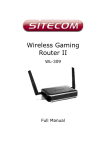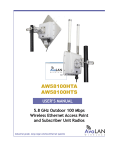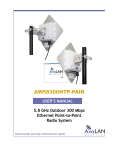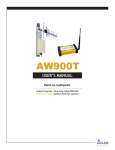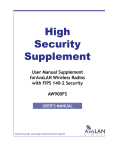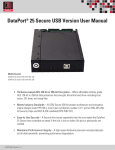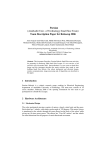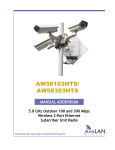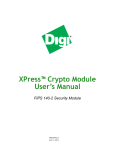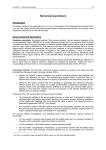Download User Manual - AvaLAN Wireless
Transcript
AW-HSNetAppliance User’s Manual FIPS 140-2 High Security Network Appliance Industrial-grade, long-range wireless Ethernet systems AvaLAN W I R E L E S S AW-HSNetAppliance User’s Manual Thank you for your purchase of these AvaLAN AW-HSNetAppliance FIPS 140-2 High Security Network Appliances. The AW-HSNetAppliance is used to create a secure Ethernet communications tunnel through untrusted data transport systems. The security of the tunnel is provided by the NetAppliance’s AES-256, FIPS140-2 Level 2 validated, data encryption system. The NetAppliance is typically deployed as a cryptographically matched pair, each at a trusted network location, to create a network-to-network VPN tunnel over the Internet or via wireless communications equipment. Each AW-HSNetAppliance includes: • (1) High Security Network Appliance • (1) 120 VAC to 6 VDC Power Supply • (1) Standard to Mini-USB Adapter Cable Table of Contents: How the Net Appliance Works . . . . . . . . . . . . . . . . . . . . . . . . . . . 3 Step A. Gather Required Hardware and Software . . . . . . . . . . . . . . . . . . 4 Step B. Gather the Required Configuration Information . . . . . . . . . . . . . . . 4 Step C. Configure the Encryption Modules . . . . . . . . . . . . . . . . . . . . . . 5 Step D. Configure the Network Interfaces . . . . . . . . . . . . . . . . . . . . . 8 Step E. Add a Port Forwarding Rule . . . . . . . . . . . . . . . . . . . . . . . . . 10 Step F. Test the Connection . . . . . . . . . . . . . . . . . . . . . . . . . . . . . . 11 Required Information 12 Form . . . . . . . . . . . . . . . . . . . . . . . . . . . . . . If you have any questions when configuring your AvaLAN system, the best place to get answers is to visit www.avalanwireless.com. You will also find the latest updates there. If more assistance is needed, send email to [email protected]. To speak to a live technician, please call technical support at the number below during normal business hours. Limited Warranty: This product is warranted to the original purchaser for normal use for a period of 360 days from the date of purchase. If a defect covered under this warranty occurs, AvaLAN will repair or replace the defective part, at its option, at no cost. This warranty does not cover defects resulting from misuse or modification of the product. © 2012 by AvaLAN Wireless Systems Inc. All rights reserved. Revision 06.26.2012 125A Castle Drive Madison, AL 35758 Sales: (866) 533-6216 Technical Support: (650) 384-0000 Customer Service: (650) 641-3011 Fax: (650) 249-3591 Technical Support (650) 384-0000 PAGE 2 www.avalanwireless.com User’s Manual AW-HSNetAppliance How the Net Appliance Works Linked Network Main Network Gateway WAN Unsecured Public Network AvaLAN Net Appliance Server Gateway WAN AvaLAN Net Appliance Client Data Source or Destination Data Source or Destination This diagram illustrates a typical application for a secure tunnel. The Main Network might be a corporate LAN and the Linked Network might be a public LAN in a hotel. When the two Net Appliances are configured and linked, a virtual private network (VPN) is created that behaves as though the two networks are connected with a simple Ethernet cable. What makes this different from other VPNs? The AW-HSNetAppliance is unique in its simplicity, allowing the formation of a network-tonetwork connection that only requires a fixed IP address and port forwarding at one of the two gateway locations. The second gateway can be dynamically addressed without port forwarding and the remote Net Appliance can use DHCP for its address. This allows for an exceptionally simple user experience at the second location because the Net Appliance can be placed on any remote network and it will immediately create a VPN tunnel to the other side. How is the AW-HSNetAppliance used and installed? Two Net Appliances work as a matched pair using the same encryption key to encrypt and decrypt the traffic between the devices. The first Net Appliance is typically installed on a trusted network with MAC address restrictions allowing access only to approved network resources. Physical installation requires simply attaching each Net Appliance to an open socket on a switch that is part of each local network. How does the AW-HSNetAppliance work? For simplicity let us consider data flow in just one direction. The Net Appliance’s tunnel operates by encrypting packets received on its Ethernet port. Once encrypted, the packets are then encapsulated within a new packet structure that has the IP address destination set to that of the remote gateway. The packet is then sent out from the NetAppliance’s Ethernet port through the local network gateway and onto the unsafe network (often the Internet or Technical Support (650) 384-0000 PAGE 3 www.avalanwireless.com AW-HSNetAppliance User’s Manual wireless), destined for the safety of the remote gateway’s firewall. At the remote firewall, the packet arrives and is forwarded to the LAN IP address of the remote Net Appliance. The packet is received by that Net Appliance through its Ethernet port, the encapsulation header is removed, the packet is decrypted and then sent to its ultimate destination on the remote network. In actual operation, packets flow in two directions simultaneously. Packets enter a Net Appliance as either ordinary packets needing encapsulation/encryption or as encapsulated/ encrypted packets needing to be made ordinary. Packets exit the NetAppliance destined either for the gateway as encrypted/encapsulated packets ready for travel over the unsafe network or exit as ordinary packets ready for the local network. How is the data protected? Packets sent through the tunnel are encrypted with advanced algorithms and the management of passwords and keys within the Net Appliance is handled via a separate interface conforming to the requirements of FIPS 140-2 Level 2. To create a point-to-point secure tunnel between two LANs, follow these steps: Step A. Gather the required hardware and software. You will need: • Two AW-HSNetAppliance units. • A Windows PC with a wired LAN port, a USB 2.0 port and a web browser. • A copy of the AvaLAN IP Finder Utility (xTR/iTR series) that can be downloaded from www.avalanwireless.com/downloads.php. • A copy of the AvaLAN AW140 Crypto Module Interface Utility that can also be downloaded from the same web location. • Ethernet cables to connect the AW-HSNetAppliance units to the PC for configuration and to appropriate ports on their respective LANs to be linked. • A Standard to Mini USB adapter cable (included with each AW-HSNetAppliance). Step B. Gather the required configuration information You will need: • IP Address, login information for the firewall/gateway between the Main Network and the WAN (wide area network) connection to the unsecured public network. If you are not privy to this information, seek the help of the IT person who is. • The external (WAN) IP address at the Main Network location. • A port number to use for the open port in the firewall for the Main Network location to be used for forwarding packets from the WAN side of the firewall to the LAN address of the Net Appliance. • The Crypto Officer’s password to the Encryption Module inside the Net Appliance. If you do not know this, it can be reinitialized. • A 128, 192, or 256 bit private key to enter into each Encryption Module, represented as 32, 48 or 64 hex digits. Technical Support (650) 384-0000 PAGE 4 www.avalanwireless.com User’s Manual AW-HSNetAppliance • The login information to the AW-NetAppliance web interface. This is a default of “ad- min” and “password.” If it has been changed and you don’t know what it is, you may need to do a complete reinitialize. • A static IP address, netmask and gateway address for the Net Appliance at the Main Network location. (Seek the help of the IT person for the Main Network if you do not have direct control over this.) • MAC addresses of any devices that are allowed to use the Net Appliance’s tunnel (all devices are allowed by default, but you can limit this to a list of up to 24 specific devices at each end.) We recommend writing down a list of these items before proceeding further. You will need the answers to all of the above to complete the configuration of your secure tunnel. For your convenience, use the form provided in the back of this manual. Step C. Configure the Encryption Modules To program the encryption module within the AW-HSNetAppliance, a PC must be connected to the USB port on the end of the case: The PC must have two critical pieces of software installed: 1. A driver that provides a virtual COM port through the USB connection. Such a driver is already included with Windows XP, Vista or 7 and should automatically be located and loaded when the USB connection is first made. 2. The AW140 Crypto Module Interface utility that can be downloaded from our website, www.avalanwireless.com. Look for it on the Downloads page under the Support tab. The file is a zip archive containing an installer for the utility. Unzip and run it to install the utility on your PC. If you prefer to use a computer with a non-Windows operating system, it is also possible to program the module with a virtual COM port driver and a generic terminal emulator. Contact AvaLAN Technical Support for help with this feature. The person having access to the programming interface is referred to by the FIPS 140-2 Standard as the Crypto Officer. As the Crypto Officer, part of the responsibility for data security rests with your choice of a strong login password and encryption key. Make sure you do not lose the login passwords and encryption key because they cannot be retrieved from the Net Appliances in any fashion. Technical Support (650) 384-0000 PAGE 5 www.avalanwireless.com AW-HSNetAppliance User’s Manual Step by Step Configuration Procedure: 1. Turn off the power to the Net Appliance by unplugging its DC power cable and connect the USB port to your computer using the USB mini B cable. Then re-apply power to the Net Appliance. The unit’s encryption module will enter its programming mode only if a powered USB cable is attached and the main power is cycled off and then on. 2. Run the Crypto Module Interface utility on your PC. You should see a startup window like this, with everything greyed out except the Connect button and a dropdown list of COM ports. Usually there will be just one. If there are more, repeat Step 1 to determine which COM port applies to this radio by seeing it disappear and reappear in the list. 3. Choose the correct COM port and press the Connect button. The utility window will then show a successful connection by activating the Login and Reset choices and displaying “Module Connected” in the status box. 4. If you know the Crypto Officer password and want to change the encryption key, choose Login. if you are initializing the module for the first time or wish to reset both the password and key, choose Reset. After a warning popup, you will be able to enter a new Crypto Officer password. This must be between 8 and 32 characters and may include letters, numbers and symbols and is casedependent. If you forget the password, there is no way to retrieve it. You will need to reset the module and begin again. If you know the password and have logged in, you may change it by clicking “Change Password.” 5. Next, you will be provided with a popup to enter the encryption key and method (128, 192 or 256-bit). (You will be forced here if you are resetting, or can choose “Input Key” after logging in. The encryption key is a hexadecimal number, 32 digits for 128-bit encryption, 48 digits for 192-bit and 64 digits for 256-bit. Enter the digits as 0 - 9 and a - f or A - F (case independent). If you enter fewer than the specified number of digits (not recommended), the remainder will be padded with zeros. (To avoid errors and preserve your sanity, you will likely want to cut and paste this key from a text file.) Technical Support (650) 384-0000 PAGE 6 www.avalanwireless.com User’s Manual AW-HSNetAppliance 6. Once the encryption module has been programmed, you may login to access the other features. “Self Test Results” will simply display “Self Test Passed” in the status box. If it does not, contact AvaLAN Technical Support. Module Firmware Version displays that information in the status box and may be useful to the aforementioned AvaLAN Technical Support staff. 7. When you are finished with the configuration of the encryption module, disconnect the USB cable and replace the cap on the connector. Then cycle power through the LAN cable to restore the Net Appliance to normal operation. 8. Repeat the programming procedure with the other Net Appliance. its Crypto Officer password can be different if you wish, but the encryption method and key must be the same. Technical Support (650) 384-0000 PAGE 7 www.avalanwireless.com AW-HSNetAppliance User’s Manual Step D. Configure the Network Interfaces One Net Appliance, normally the one on the Main Network, must be configured as a Server and the other Net Appliance that will be used on the Linked Network must be configured as a Client. Configuration is performed by using a web browser to interact with the web interface built in to the product. In order to browse to a Net Appliance’s web interface, you must know its IP Address and be able to connect to it from your computer through the local wired network. As indicated on the product label, the factory default IP Address is 192.168.17.17 and the default password is “password.” The login name is “admin” and cannot be changed. 1. Your network may not have a netmask or IP address range that can see 192.168.17.17. So to make the connection, you will need a computer such as a laptop PC that has a wired LAN port and whose LAN interface can be changed at least temporarily to 192.168.17.xxx (“xxx” not 17). After changing your PC’s address, connect it to the Net Appliance and use your browser to connect to http://192.168.17.17. You will be asked for a login name and password: enter “admin” and “password” for these items. 2. If successful, you will see a screen similar to this one. The page header shows the current Firmware Version, the Net Appliance’s MAC Address, the type of Ethernet connection and the time since last reboot. Clicking on the AvaLAN logo or the URL link will open www.avalanwireless.com in a new tab or window. Below the header is a navigation bar that can take you to two other configuration pages. This home page displays the current status, the amount of data exchanged since last reset and the activity load on the encryption CPU. Skip ahead to Step 4. 3. If you are not successful at browsing to the Net Appliance, its IP address may have been changed. You can choose to reset the unit to factory defaults or you can use our AvaLAN IP Finder Utility to locate its IP address. To reset to factory defaults, there is a small white button visible through a hole on the bottom of the Net Appliance’s case. While the unit is powered on, press and hold this button for about 5 seconds (you will see the LED display on the top of the case change state). To use the IP Finder, download it from www.avalanwireless.com. Look for it on the Downloads page under the Support tab. The file is a zip archive containing the executable utility. Unzip it to any desired folder on your PC and run it. Clicking search will show all AvaLAN devices on the network (there should be just the Net Appliance) and the information shown should allow you to browse to it. Technical Support (650) 384-0000 PAGE 8 www.avalanwireless.com User’s Manual AW-HSNetAppliance 4. Having successfully logged in to the Net Appliance’s web interface, click the “General Settings” tab in the navigation bar. This screen will appear and you will first need to configure this unit to be a Server. In the “Device Type” section of the page, click the Server radio button and then click “Apply.” The Net Appliance will reboot and you should be returned to the home page in a few seconds. 5. For the Server Net Appliance, you will need to specify the IP Address, Subnet Mask, Gateway Address and Tunnel Port that the device will use when connected to the Main Network. On the “General Settings” page and in the “Local Network Settings” section, enter these parameters and click “Apply.” Note that your choice of Server rather than Client caused the “Remote NetAppliance Settings” section and the choice of “DHCP” or “Static” to disappear since these items do not apply. 6. If you wish to add MAC Address filtering or change the web interface password, click on the “Advanced” tab in the navigation bar. Enter the desired information and click the appropriate “Apply” buttons. The “Upload New Firmware” section on this page is for use whenever AvaLAN releases an update for the product. 7. With the second Net Appliance unit, browse to it in the same fashion as before in Steps 1 to 3. Once successfully logged in, choose the “General Settings” tab in the navigation bar and then click the “Client” radio button and then click the “Apply” button in the “Device Type” section. The Net Appliance will reboot and you should be returned to the home page in a few seconds. Technical Support (650) 384-0000 PAGE 9 www.avalanwireless.com AW-HSNetAppliance User’s Manual 8. For the Client Net Appliance, you need not specify a static IP Address, Subnet Mask or Gateway Address, but can choose instead to allow the Linked Network’s DHCP Server to provide them. Or if it is more appropriate, choose “Static” and enter the three parameters. If you choose “DHCP”, the three parameter entry boxes are grayed out to indicate that they may not be changed. You do need to specify the Remote IP Address and Remote Tunnel Port Number in the “Remote NetAppliance Settings” section of the page. The Remote IP Address is the public or WANside IP Address of the Main Network. The Port number is the same as the one you chose for the Server Net Appliance Local Tunnel Port. 9. In similar fashion to Step 6, you can change the Client Net Appliance web password, add MAC Address Filtering or update firmware on the “Advanced” page. Step E. Add a port forwarding rule The last and very important step in the configuration process is to add a port forwarding rule in the configuration information for the Main Network Gateway. This rule needs to specify that traffic arriving from the WAN side with the port number chosen in Step B is directed to the IP Address of the Server Net Appliance. Each router/firewall has its own method for setting this, so detailed instructions cannot be given. Here is an example screen from one such router: Typically you can provide a name of your choice for the rule — pick something that will remind your future self about why the rule was established. Then, you can specify the port number and the IP address as well as the type of traffic allowed. If you have difficulty with this step, your IT person or AvaLAN Technical Support may be able to help. Technical Support (650) 384-0000 PAGE 10 www.avalanwireless.com User’s Manual AW-HSNetAppliance Step F. Test the connection When the configuration is complete, connect the Net Appliances to available ports on their respective LANs, the Server on the Main Network LAN and the Client on the Linked Network LAN and apply power to them. A computer on the respective LAN can be used to browse to the Net Appliance there to check on the status. An even easier, though less complete way to check the status is to view the LEDs on the top of the Net Appliance case. As soon as the units are connected and active, they attempt to connect. The Statistics page (home page) of each Net Appliance and its LEDs will indicate a status of “Searching.” The Server will remain in this state until the Client makes connection, then the status will change to “Connected.” On the Client side, if the Server does not connect after 2 minutes an error message, “Server is unreachable” will appear. When the two units are successfully connected, the tunnel can be tested by sending traffic from a device on one LAN to a device on the other. The Net Appliance Statistics page will show incrementing counts of transmitted and received data. Technical Support (650) 384-0000 PAGE 11 www.avalanwireless.com AW-HSNetAppliance User’s Manual Required Information Form 1. Firewall/gateway for the Main Network: IP Address: ____.____.____.____ Login Name: __________________________ Tunnel Port #: _________________________ Ext (WAN) IP Address: ____.____.____.____ Password: ____________________________ 2. FIPS 140-2 Encryption (set alike in both Net Appliances): Crypto Officer’s Password: ____________________________ Method: 128 Bit 192 Bit Encryption Key: 32, 48 or 64 Hex Digits 256 Bit 3. Server Net Appliance: IP Address: ____.____.____.____ Subnet Mask: ____.____.____.____ Gateway: ____.____.____.____ Login: admin, Password: ________________ MAC Address Filtering: Enabled Disabled ____:____:____:____:____:____ ____:____:____:____:____:____ ____:____:____:____:____:____ ____:____:____:____:____:____ ____:____:____:____:____:____ ____:____:____:____:____:____ ____:____:____:____:____:____ ____:____:____:____:____:____ ____:____:____:____:____:____ ____:____:____:____:____:____ ____:____:____:____:____:____ ____:____:____:____:____:____ ____:____:____:____:____:____ ____:____:____:____:____:____ ____:____:____:____:____:____ ____:____:____:____:____:____ ____:____:____:____:____:____ ____:____:____:____:____:____ ____:____:____:____:____:____ ____:____:____:____:____:____ ____:____:____:____:____:____ ____:____:____:____:____:____ ____:____:____:____:____:____ ____:____:____:____:____:____ 4. Client Net Appliance: Addressing: DHCP Static IP Address: ____.____.____.____ Subnet Mask: ____.____.____.____ Gateway: ____.____.____.____ Login: admin, Password: ________________ MAC Address Filtering: Enabled Disabled ____:____:____:____:____:____ ____:____:____:____:____:____ ____:____:____:____:____:____ ____:____:____:____:____:____ ____:____:____:____:____:____ ____:____:____:____:____:____ ____:____:____:____:____:____ ____:____:____:____:____:____ ____:____:____:____:____:____ ____:____:____:____:____:____ ____:____:____:____:____:____ ____:____:____:____:____:____ ____:____:____:____:____:____ ____:____:____:____:____:____ ____:____:____:____:____:____ ____:____:____:____:____:____ ____:____:____:____:____:____ ____:____:____:____:____:____ ____:____:____:____:____:____ ____:____:____:____:____:____ ____:____:____:____:____:____ ____:____:____:____:____:____ ____:____:____:____:____:____ ____:____:____:____:____:____ Technical Support (650) 384-0000 PAGE 12 www.avalanwireless.com












